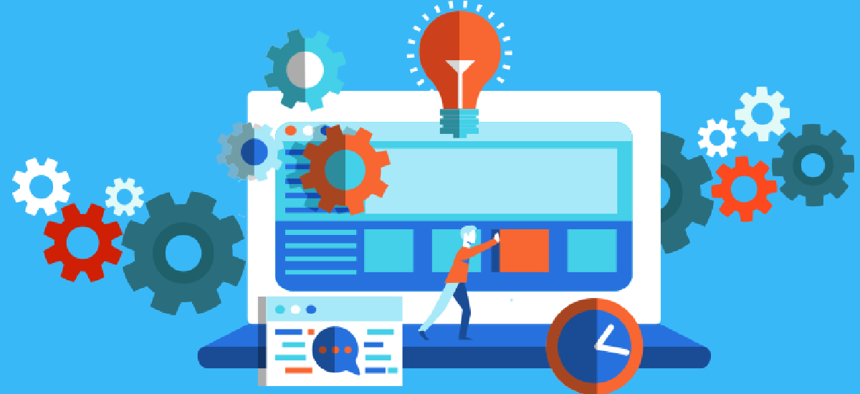How ready-to-use apps expedite citizen services

With low-code development, local governments can maintaining business continuity and future-proof their citizen-service model.
The phrase, “the new normal” will be forever associated with reshaping of society at the start of this decade. Alongside “social distancing” and “global pandemic,” it is now burned into our collective consciousness, defining how COVID-19 has redefined how Americans work, socialize and interact with both private- and public-sector entities. For local governments on the front lines of responding to the pandemic and protecting their citizens, the new normal applies to nearly every aspect of operations, from remote work and virtual meetings to how they manage the myriad of citizen requests for forms, services and information.
Traditional paper-based processes for responding to such requests has become impossible in today’s world that depends on decentralized staff and contactless interactions, so local government leaders have been forced to shift their infrastructure and service model priorities — and to do so quickly, cost-effectively and with reduced staff. To adapt to the realities of the new normal of citizen service delivery, local governments are turning to ready-to-implement forms and applications and the booming low-code software movement.
Shifting priorities
In the summer of 2020, CivicPlus surveyed local government leaders on the next normal in civic service. Respondents consistently signaled that local government work and public service delivery had been permanently changed in response to the pandemic. For example, when asked about the top issues their local government was, is and will be focusing on, about 15% said community and crisis communications was a priority six months earlier. That percentage understandably boomed to over 40% who believed it to be a current priority, and just under 30% predicted it to remain so in a year.
When asked about new technology priorities, 58% cited payment and revenue capture technology, 56% cited online forms and 44% cited citizen request management. Seventy-six percent of respondents also said their communities would adopt more software to streamline public services moving forward. Respondents identified these technology categories as most relevant to short and long-term needs:
- Work from home capabilities (48%)
- Online revenue and payment capture (46%)
- Community engagement (45%)
- Public service workflows (36%)
- Community and crisis communications (32%)
Approximately 80% of respondents said they believe that the shift from paper to digital processes will be permanent, with 80% also believing that software that promises savings (e.g., staff time) has become more attractive since March 2020.
The flexibility and extendibility of low-code software
In the wake of the COVID-19, low-code software systems are helping local governments rapidly digitize citizen services that for decades have been handled via in-person, in-office, paper-based processes. Such workflows are no longer feasible for administrations whose staff members are now remote. With low-code development, local governments are maintaining business continuity and future-proofing their citizen service model.
Low-code software not only enables agencies to create and deploy ready-to-use mobile apps and forms for everything from vaccine registrations, contact tracing and pet registrations to marriage license requests, but it also offers a crucial transformative opportunity. Low-code software helps local governments transform the relationship between citizens and municipalities by expanding local governments’ footprint and extending citizens’ ability to benefit from more streamlined, cost-effective and responsive service access.
While the COVID-19 pandemic may have accelerated the shift from phone calls and paper forms to digital applications, the last two decades of shrinking government budgets and staffs have foreshadowed the need for public-sector digital transformation.
The role of digital applications and online forms in the new normal
Local governments have proved their resilience during the pandemic. In every state, municipalities of every size are embracing online applications and low-code capabilities to streamline established processes and provide more personalized and accessible support for citizens of every generation and technical ability. There’s no going back to prepandemic days, so local governments should embrace change and the possibilities it brings.
When asked about the future of digital government, a dedicated software architect engineer for a Utah city told us:
“The pandemic is forcing local governments to make choices about where they need to go in a variety of aspects of their business models. They’re realizing that they have to provide citizens with the modern conveniences that people expect. We need to digitally catch up, and COVID-19 is forcing governments to do it rapidly. Citizens must be able to obtain and pay for services online to meet their needs; city government also must continue to earn essential revenue. So, ensuring that online services are effective and widely available is a win-win.”
COVID-19 is changing how we work and interact with businesses, brands and each other every day. From exchanging handshakes for elbow bumps and doctors’ office visits for telemedicine sessions, these changes are ushering in opportunities. They provide safety, convenience and security, and for local governments that have been racing to keep up with the private sector, they are leveling the playing field and finally accelerating local governments’ digital revolution.





